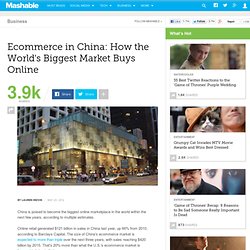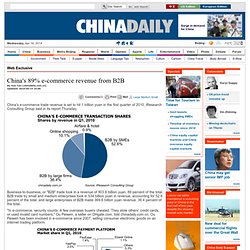

Dise Digital Signage New Shopping Experience! Japanese convenience stores look to China. Tesco Homeplus Virtual Subway Store in South Korea. KinectShop: The Next Generation Of Shopping [Exclusive Video] Virtual reality shopping just got a lot more real--and could soon become a lot more mainstream.
![KinectShop: The Next Generation Of Shopping [Exclusive Video]](http://cdn.pearltrees.com/s/pic/th/kinectshop-generation-39461838)
"KinectShop" (working title), an augmented reality shopping platform for the Xbox Kinect, exploits the system's new finger-recognition technology to allow shoppers to grab items from an unlimited shelf of clothes, see how accessories look at multiple angles, and share the photos with friends on Twitter and Facebook for a quick thumbs-up or down.
"The customer can visually see what an object looks like on them without even entering a retail store," Steve Dawson, Technology Director for the Emerging Experiences group at Razorfish tells Fast Company. Unlike existing virtual shopping that shoehorns 2-D photos on top of body snapshots, "with Kinect, you can find the physical outlines of a person and map it to your body. " The Web Is Dead. Long Live the Internet. Two decades after its birth, the World Wide Web is in decline, as simpler, sleeker services — think apps — are less about the searching and more about the getting.

Chris Anderson explains how this new paradigm reflects the inevitable course of capitalism. And Michael Wolff explains why the new breed of media titan is forsaking the Web for more promising (and profitable) pastures. Who’s to Blame: Us As much as we love the open, unfettered Web, we’re abandoning it for simpler, sleeker services that just work. by Chris Anderson You wake up and check your email on your bedside iPad — that’s one app. "China 2.0: Tencent, Taobao and Baidu" for conference at Stanford University. eCommerce Evolution. How can you make online grocery shopping more attractive? - is 3D technology an option? The History of eCommerce – Timeline Infographic. If you ever wondered how the electronic commerce started, now we’ll answer all your questions!

Today’s awesome infographic that was diligently created by TemplateMonster provides you with a quick glimpse of how eCommerce has evolved over the years. Basically, the way it has been developing depends heavily on the technologies that have been contrived. With that said, the past several decades gave birth to absolutely essential inventions that have rapidly changed the way retailers push their businesses online.
The following infographic displays the uncommon spectacle of the eCommerce-related milestones, integrating the variety of interesting historical facts. Square COO Explains Why The Web Is Dead. Taobao Mobile Login Users Exceeded 100 Million. Top 10 B2C Websites in 2011. A guide to China's top 10 e-commerce sites - CNET Asia Blogs: Sinobytes. Global e-commerce sales will top $1.25 trillion by 2013. Global business-to-consumer e-commerce sales will pass the 1 trillion euro ($1.25 trillion) mark by 2013, and the total number of Internet users will increase to approximately 3.5 billion from around 2.2 billion at the end of 2011, according to a new report by the Interactive Media in Retail Group (IMRG), a U.K. online retail trade organization.

The study estimates that business-to-consumer e-commerce sales in 2011 increased to 690 billion euros ($961 billion), an increase of close to 20% from a year earlier. The United States remains the world’s single biggest e-commerce market, IMRG says, followed by the United Kingdom and Japan. IMRG estimates that growth rates in those countries will be approximately 10-15% a year. The Fast and Furious E-Commerce Market of China. In the past two years, Chinese consumers have opened their wallets and pocketbooks online.

Online buying and selling, including group purchasing (through the Chinese equivalents of Groupon), is the second-fastest-growing activity, after microblogging. These rapid rises in usage reflect more than just expansion from a small base. Online shopping is now the fourth-most-popular online activity in China, and two of the more popular activities—IM and online games—are declining in usage.
Online shopping is here to stay. Companies cannot have a major presence in China without having an online presence, not only to generate sales but also to engage with customers where they spend so much time.
Dealers reaction to online trading law. Real name registration mentioned in the on-line trading regulations has triggered wide concerns among dealers.

What impact will it have on the growing cyber business? College student Wei runs a small on-line shop selling clothes and cosmetic products. She withholds her real identity online and her store was named randomly. Wei, on-line dealer, said, "My name and postal address registered with Alipay are all real. But the names of the store and the owner are not. " Wei's store operates on a certain shopping site. Wei said, "Buyers always have doubt about my credit and my products as my credit gauge is on a low level.
The real name registration may ease buyers' doubts about dealers. Zhou, on-line dealer, said, "If there is not any fee involved, it doesn't make any difference. Currently, the country's major e-commerce platforms have already required large-sized stores to register under their real names. China to Lead Online Trading in Next Five Year. Ecommerce in China: How the World's Biggest Market Buys Online. China is poised to become the biggest online marketplace in the world within the next few years, according to multiple estimates.

Online retail generated $121 billion in sales in China last year, up 66% from 2010, according to Barclays Capital. The size of China's ecommerce market is expected to more than triple over the next three years, with sales reaching $420 billion by 2015. That's 20% more than what the U.S.'s ecommerce market is forecast to bring in that year. China has an estimated 193 million online shoppers, more than any other country. A number of factors are driving the growth. Shipping prices and reliability have also been improved, particularly in urban coastal cities: Shipping costs Chinese corporations about a sixth of what their American counterparts pay, according to BCG. China's 89% e-commerce revenue from B2B. By Hao Yan (chinadaily.com.cn) Updated: 2010-05-14 10:56 China's e-commerce trade revenue is set to hit 1 trillion yuan in the first quarter of 2010, iResearch Consulting Group said in its report Thursday.

Business-to-business, or "B2B" trade took in a revenue of 903.6 billion yuan, 89 percent of the total. B2B trade by small and medium enterprises took in 534 billion yuan in revenue, accounting for 52.6 percent of the total, and large enterprises of B2B made 369.6 billion yuan revenue, 36.4 percent of the total. "In e-commerce, security counts. A few overseas buyers cheated. China wants global ecommerce crown. High performance access to file storage China has revealed ambitious growth plans to lead the word in e-commerce, quadrupling web sales to reach 18 trillion (£1.4tr) by 2015, but laid out a strict new set of policy measures to get there.

A lengthy missive sent from the Ministry of Industry and Information Technology (MIIT) outlines the country’s 12th ‘five year plan’ for e-commerce which, bizarrely, began last year and runs to 2015.